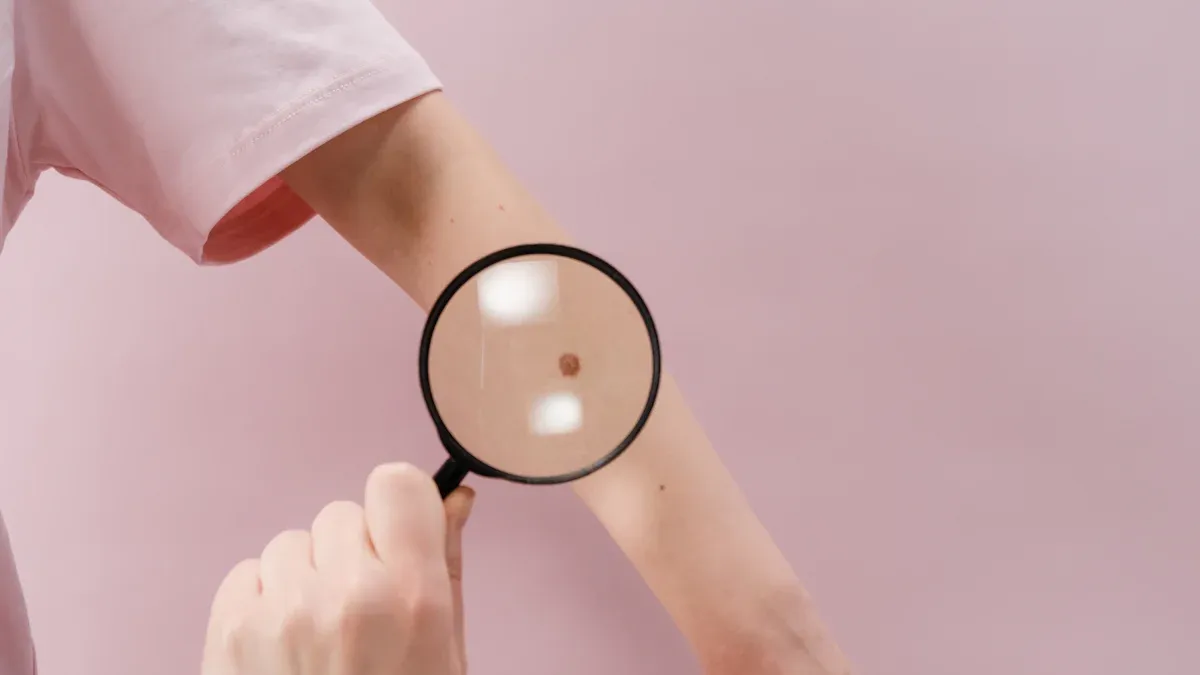What is Basal Cell Carcinoma and How to Identify Its Symptoms

Basal cell carcinoma is the most common form of skin cancer, accounting for nearly 80% of cases worldwide. It develops when basal cells, which form the outermost layer of your skin, grow abnormally. This type of cancer grows slowly and rarely spreads to other parts of the body. Early treatment offers a high chance of success, with cure rates reaching up to 99% for small, low-risk lesions. Recognizing unusual skin changes early can help you seek timely medical care and prevent complications.
Key Takeaways
Basal cell carcinoma is a very common type of skin cancer. Finding it early helps with better treatment.
Check your skin often to spot any strange changes. Look for new spots or sores that don’t heal each month.
Use sunscreen, wear hats and long sleeves, and skip tanning beds to protect your skin from UV rays.
See a skin doctor if you notice changes that don’t go away. Catching it early can make treatment easier.
Knowing the signs and risks of basal cell carcinoma helps you care for your skin better.
What is Basal Cell Carcinoma?
Basal Cells and Their Role
Basal cells are microscopic cells located in the epidermis, the outermost layer of your skin. These cells play a vital role in maintaining skin health. They divide and produce new skin cells, which replace older ones. As new cells form, older cells move to the surface of your skin, where they eventually die and shed. This continuous process keeps your skin healthy and functional.
How Basal Cell Carcinoma Develops
Basal cell carcinoma begins when basal cells grow abnormally due to genetic mutations. These mutations disrupt the normal cell replication process, causing uncontrolled cell growth. Several factors can trigger these mutations:
Excessive exposure to ultraviolet (UV) rays.
DNA damage that prevents proper cell replication.
Basal cells producing new cells without stopping, leading to tumor formation.
This abnormal growth results in the development of basal cell carcinoma, the most common type of skin cancer.
Key Characteristics of Basal Cell Carcinoma
Basal cell carcinoma has distinct features that set it apart from other skin cancers. It often appears as a small, shiny bump or a scaly, flat patch. Over time, it grows slowly and may develop into open sores, red patches, or lesions that ooze, crust, or bleed. These changes typically occur in sun-exposed areas like your face, neck, or arms. While basal cell carcinoma is rarely life-threatening, some cases may grow rapidly or invade deeper tissues. Early detection and treatment can prevent complications.
Symptoms of Basal Cell Carcinoma

Common Symptoms
You may notice several signs that could indicate basal cell carcinoma. These symptoms often appear as changes in your skin that persist or worsen over time. Some of the most commonly reported symptoms include:
A sore that doesn’t heal or heals and then returns. It may bleed, ooze, or crust over.
A scaly, slightly raised patch of irritated skin. This patch could be red, pink, or another color.
A round growth that might be pink, red, brown, black, tan, or even the same color as your skin.
A spot on your skin that feels rough or scaly to the touch.
A scar-like mark that appears white, yellow, or skin-colored and has a waxy texture.
These symptoms often develop slowly, making it important to monitor any unusual changes in your skin.
Variations in Appearance
The appearance of basal cell carcinoma can vary depending on your skin type. If you have lighter-colored skin, you might notice small, pink or red bumps that look shiny or pearly. These bumps may also appear translucent. On darker skin, the lesions could be darker in color but still retain features like a shiny surface or raised edges. Understanding these variations can help you identify potential warning signs more effectively.
Areas Commonly Affected
Basal cell carcinoma typically develops on parts of your body that receive the most sun exposure. These areas include your face, neck, ears, scalp, shoulders, and arms. However, it can also appear in less exposed areas, so it’s important to check your entire body during self-examinations. Pay close attention to spots that seem unusual or don’t heal properly.
How to Identify Symptoms
Self-Examination Techniques
Regular self-examinations can help you detect early signs of basal cell carcinoma. Follow these steps to thoroughly check your skin:
Inspect your underarms, arms (both sides), hands, and fingers, including under your nails.
Check your thighs, shins, feet (tops and soles), toes, and toenails.
Use a hand mirror to view the backs of your thighs, calves, and feet.
Look at your buttocks, genital area, back, and the back of your neck and ears using a hand mirror.
Part your hair with a comb or hair dryer to examine your scalp.
Tip: Pay attention to new or changing growths, sores that don’t heal, or scaly patches. These could be early signs of basal cell carcinoma.
Performing these checks monthly can help you spot unusual changes early.
When to Consult a Dermatologist
If you notice persistent or unusual skin changes, consulting a dermatologist is crucial. Warning signs include:
A sore that doesn’t heal, bleeds, or crusts over repeatedly.
A scaly, irritated patch of skin that feels rough to the touch.
A round growth that may be pink, red, brown, or even skin-colored.
A scar-like mark with a waxy texture.
Early recognition of symptoms ensures timely treatment and prevents complications. If you observe any of these signs, schedule a dermatologist visit promptly.
Successful treatment of basal cell carcinoma depends on early detection. Don’t ignore persistent skin changes, even if they seem minor.
Causes and Risk Factors of Basal Cell Carcinoma
Primary Causes
Basal cell carcinoma develops when the DNA in your skin’s basal cells becomes damaged. This damage often results from prolonged exposure to ultraviolet (UV) rays, either from sunlight or tanning beds. UV radiation harms the DNA, leading to mutations that disrupt the normal growth cycle of basal cells. Instead of dying off as they should, these cells multiply uncontrollably, forming tumors or lesions on your skin.
You might notice these tumors as slowly growing plaques or nodules. They can vary in size, from a few millimeters to several centimeters, and may appear skin-colored, pink, or pigmented. Over time, these lesions might bleed, ulcerate, or develop a crusty surface.
Note: Protecting your skin from UV exposure is one of the most effective ways to prevent this type of DNA damage.
Risk Factors
Certain factors increase your likelihood of developing basal cell carcinoma. These include:
Ultraviolet (UV) light exposure: Spending long hours in the sun or using tanning beds significantly raises your risk.
Light-colored skin: If you have fair skin, you are more prone to this condition than those with darker skin tones.
Age over 50: Most cases occur in individuals over the age of 50.
History of skin cancer: If you’ve had basal cell carcinoma, squamous cell carcinoma, or melanoma before, your risk is higher.
Male gender: Men are more likely to develop this condition than women.
Chronic skin conditions: Burns, scars, or long-term skin infections can also contribute to your risk.
Research shows that about 90% of nonmelanoma skin cancers, including basal cell carcinoma, are linked to UV radiation. In the U.S. alone, over 419,000 cases of skin cancer each year are associated with indoor tanning, with approximately 245,000 of these being basal cell carcinoma.
Understanding these causes and risk factors can help you take proactive steps to protect your skin and reduce your chances of developing this common form of skin cancer.
Prevention of Basal Cell Carcinoma

Protecting Your Skin
Taking steps to protect your skin can significantly reduce your risk of basal cell carcinoma. You should prioritize shielding your skin from harmful UV rays, which are a leading cause of this condition. Here are some effective ways to safeguard your skin:
Use sunscreen daily with an SPF of 30 or higher. Apply it generously and reapply every two hours, especially if you are swimming or sweating.
Wear protective clothing, such as long-sleeved shirts, wide-brimmed hats, and sunglasses.
Seek shade whenever possible, particularly during midday when the sun’s rays are strongest.
Avoid tanning beds, as they emit UV radiation that can damage your skin.
Tip: Consider taking oral nicotinamide (vitamin B3) supplements. Research suggests it may help reduce the risk of certain skin cancers, including basal cell carcinoma.
Avoiding UV Exposure
UV exposure plays a major role in the development of basal cell carcinoma. Most cases occur on areas of the skin frequently exposed to sunlight, such as the face, neck, and arms. Both short-term intense exposure, like sunburns, and long-term cumulative exposure contribute to skin damage. To minimize UV exposure:
Stay indoors or in shaded areas between 10 a.m. and 4 p.m., when UV rays are strongest.
Use sunscreen even on cloudy days, as UV rays can penetrate through clouds.
Limit outdoor activities during peak sunlight hours.
Approximately 90% of nonmelanoma skin cancers, including basal cell carcinoma, are linked to UV radiation. Reducing your exposure can significantly lower your risk.
Importance of Regular Skin Checks
Regular skin checks are essential for early detection of basal cell carcinoma. By examining your skin monthly, you can identify unusual changes, such as new growths, sores that don’t heal, or scaly patches. Early detection allows for prompt treatment, improving outcomes and reducing complications.
You should also schedule annual visits with a dermatologist for professional skin screenings. These check-ups are especially important if you have a history of skin cancer or other risk factors.
Note: Skin cancer screenings are one of the most effective tools for catching basal cell carcinoma early. Make them a part of your routine to protect your skin and health.
When to Seek Medical Attention
Warning Signs
Recognizing the warning signs of basal cell carcinoma (BCC) can help you seek medical attention before the condition worsens. Pay close attention to the following symptoms:
A sore that doesn’t heal, bleeds, or crusts over repeatedly. It may seem to heal but then reopens and oozes fluid.
A reddish or irritated patch of skin that feels itchy or painful. This patch may crust over and appear on areas like your face, chest, or arms.
A shiny bump or nodule that looks pearly or translucent. It may be pink, red, or even darker, resembling a mole.
A pink growth with raised edges and a crusty center. Over time, tiny blood vessels may appear on its surface.
A scar-like patch of skin that looks white, yellow, or waxy. This patch often grows slowly and may feel taut or shiny.
Tip: If you notice any of these signs, don’t wait for them to disappear on their own. Early consultation with a dermatologist can prevent complications.
Benefits of Early Detection
Detecting basal cell carcinoma early offers significant advantages. Smaller lesions are easier to treat and require less invasive procedures. Early treatment reduces the risk of the cancer spreading deeper into your skin or affecting nearby tissues. It also minimizes the chances of disfigurement, especially in visible areas like your face or neck.
Delaying diagnosis can lead to larger tumors, which complicate treatment and increase costs. For example, treating a small lesion with a simple procedure like curettage is less expensive than addressing an advanced tumor with surgery. Early detection not only saves you from potential discomfort but also ensures better outcomes and quicker recovery.
Note: Regular skin checks and prompt action when you notice changes can make a significant difference in your treatment journey.
Basal cell carcinoma is a common yet manageable form of skin cancer. Recognizing its symptoms early allows you to seek timely treatment and improve outcomes. Protecting your skin from harmful UV rays and performing regular self-examinations can reduce your risk. If you notice unusual or persistent changes in your skin, consult a dermatologist without delay. Early detection ensures a high success rate for treatment, helping you maintain healthy skin and peace of mind.
FAQ
What is the difference between basal cell carcinoma and melanoma?
Basal cell carcinoma grows slowly and rarely spreads to other parts of your body. Melanoma, on the other hand, is more aggressive and can spread quickly. Early detection of both types is crucial for effective treatment.
Can basal cell carcinoma return after treatment?
Yes, basal cell carcinoma can recur, especially if you have a history of skin cancer. Regular skin checks and protecting your skin from UV rays can help reduce the risk of recurrence.
Is basal cell carcinoma hereditary?
While basal cell carcinoma itself isn’t directly inherited, a family history of skin cancer may increase your risk. Genetic conditions like basal cell nevus syndrome can also make you more prone to developing this type of cancer.
Does basal cell carcinoma always require surgery?
Not always. Treatment depends on the size, location, and severity of the lesion. Options include topical medications, cryotherapy, or laser therapy. Your dermatologist will recommend the best approach for your case.
How can I tell if a skin lesion is cancerous?
Look for warning signs like sores that don’t heal, shiny bumps, or scaly patches. If you notice any unusual changes, consult a dermatologist promptly.
Tip: Use the “ABCDE” rule (Asymmetry, Border, Color, Diameter, Evolving) to evaluate suspicious spots.
---
ℹ️ Explore more: Read our Comprehensive Guide to All Known Cancer Types for symptoms, causes, and treatments.
See Also
Identifying Angioimmunoblastic T-Cell Lymphoma Symptoms Effectively
Key Symptoms and Causes of Anal Cancer Explained
Essential Information on Adrenocortical Carcinoma Symptoms
